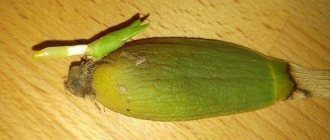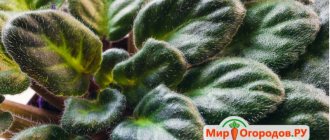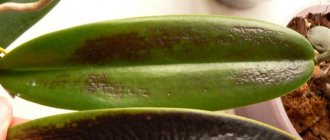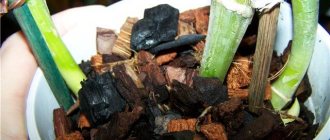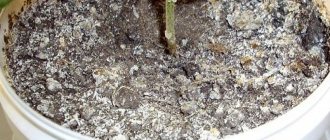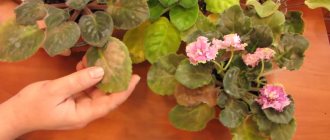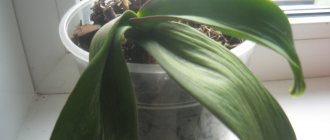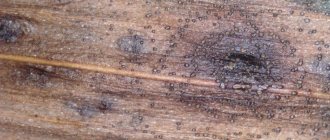Why do orchid leaves crack in half? The main causes of leaf damage in orchids
The morphological features of the leaves of almost all types of orchids are:
- Dense, leathery top layer;
- And a meaty, springy texture.
Orchid leaves crack due to improper care.
This structure most likely protects the plant from external damage, although if handled carelessly, cracks may appear on the leaves. But the main factors leading to cracking of sheet plates are violations in care regimens.
Mechanical intervention
Violation of the integrity of the leaf plate due to mechanical damage rarely occurs - flower growers are very careful when dealing with exotic beauties. But transporting a store-bought plant home, arranging it in a new place, moving from room to room or replanting is fraught with accidents:
- Scratches;
- Fold the sheet;
- And other troubles.
The injury may not be noticed at first, but over time it can lead to cracking of the leaves. If the sheet is cracked in the middle, you must first understand the reason.
Disruption of the usual biochemistry of plants
Caring for representatives of exotic flora requires careful study of their life cycles and habits, as well as compliance with all necessary regimes.
IMPORTANT! Any disturbance in the biochemical balance creates a stressful situation for orchids, which can respond to this by deteriorating their appearance, for example, by cracking of leaf plates.
Several factors lead to this kind of trouble:
- Violation of the irrigation regime;
- Incorrect feeding;
- Incorrect location in the room;
- Failures in temperature conditions;
- Problems with the root system.
If cracks appear on the leaves of the “daughters of the air”, you should:
- Analyze care methods;
- And fix the errors.
Causes of lethargy
Phalaenopsis leaves can become limp for various reasons, most of which will be closely related to caring for the trunk.
As you know, orchids in pots are quite finicky plants. In order for them to grow and develop normally, you should take all recommendations and requirements seriously.
Possible reasons why the leaves have lost turgor:
- If the roots die, as a result the plant does not receive enough moisture, the leaves especially suffer from this. Due to low water content, they begin to wilt, wrinkle and turn yellow;
- The natural aging process is the same. The trunk leaf lives for about 2-3 years, and then dies, before which it wilts;
- Overheating or frostbite have the same effect on leaf blades. They wither from too high or too low temperatures;
- Poor watering will cause the leaves to wilt. In addition, the development of the peduncle may stall, or it may simply dry out;
- Incorrectly selected fertilizing will have a detrimental effect on the condition of the foliage, and a high concentration of nutrients during watering will have the same effect. Therefore, you must strictly follow the recommendations on the packaging;
- Deterioration of turgor may be a signal from the plant about the presence of a disease or pests. If you do not react in time, you can lose the entire standard.
If the roots die, the plant loses leaf turgor.
But don’t despair if your pet’s foliage has lost its elasticity.
The orchid can be restored, but you should remember that to do this you will need to be patient and establish the cause of the turgor.
The orchid has dark green leaves. What conditions are required for a Phalaenopsis orchid?
Most often, the leaves of an orchid signal that an orchid is not feeling well: they begin to turn yellow, wither, and dry out. This does not always indicate illness. Novice amateur flower growers are likely to encounter violations of the rules of care.
With good care, the Phalaenopsis orchid will delight you with abundant flowering
Orchid owners should be aware of the natural aging of the flower. Phalaenopsis loses one or two lower leaves every year.
Yellowing of the leaves of the Phalaenopsis orchid may be due to natural processes in the plant
Required lighting level
Phalaenopsis orchids do not tolerate direct sunlight, but they love good lighting. Therefore, the best place to place them would be a window sill on the east or west side of the room.
On a south window, an orchid of this type must be shaded, moving away from the glass or covering it with a screen from a source of direct light.
Don’t forget that proper growth and healthy development are possible with 12–15 hours of daylight. From mid-autumn and throughout the winter, install additional lighting above the orchids, for example, a phytolamp. This light source is the best option; it does not damage the leaves. The only rule is that the lamp should be no closer than 20 cm from the plant.
If the leaves have darkened, become soft and elongated, this indicates a lack of light.
For the winter, install additional lighting for orchids
External factors: room temperature and humidity
Orchids are tropical flowers and need warmth. For Phalaenopsis, you need to maintain the room temperature within 20–25°C. The minimum permissible for an orchid (and only in certain cases, for example, during the dormant period) is not lower than 12°C.
The ideal humidity level for this type of plant is 70–80%. It is difficult to achieve such an indicator in the entire room, and it is not very useful for people. The best option would be to regularly ventilate the room (but do it carefully, Phalaenopsis cannot tolerate cold drafts) and increase the air humidity using one of the following methods.
- Spray the orchid with a spray bottle three times a day, without touching the buds and flowers. Please note that by night the moisture on the leaves should dry out. If there is a risk of direct sunlight, move the orchid pot to a more shaded place, otherwise the water drops will act as a lens, causing burns to the plant leaves.
To ensure the desired level of humidity, spray orchids with a spray bottle.
- Place a tray with pebbles under the orchid pot. Constantly add water to it. As it evaporates, it will moisten the flower in the required volume. It is very important that there are no roots in this water: they can get wet, become susceptible to fungal diseases and rot.
- If you have an aquarium at home, place a Phalaenopsis orchid next to it. This looks organic and provides the necessary humidity.
- rain;
- left for at least a day;
- boiled;
- passed through a household filter.
Proper watering
For Phalaenopsis orchids it is better to use water:
If you wrap 10 g of peat in gauze, dip this bag in 10 liters of water and leave for a day, this will soften the water.
Watering rules:
Water the orchid after the substrate dries
If the problem clearly exceeds acceptable limits and is not related to aging or care errors, you will have to look for the cause in disease and exposure to pests.
Viral diseases
More often than other genera of orchids, a viral disease can affect cymbidiums, cattleyas, phalaenopsis and vandas.
The last thing you should be afraid of is viral diseases, since they rarely affect orchids. Most often they appear as mosaic spots on leaves and flowers. Also, with viral diseases, characteristic spots in the form of circles, stripes or arrows can be seen on domestic “tropicanas”.
Unfortunately, it is not possible to cure an orchid affected by a viral disease. If you suspect that something is wrong with an epiphytic pet, it should be urgently isolated from other plants. If the assumption is confirmed, then the diseased orchid will have to be disposed of.
Forewarned is forearmed. Now you know everything about orchid diseases and, if something happens, you can protect your plants from their silent enemies.
The orchid's leaf burst. Why do orchid leaves crack and how to help the plant
A blooming orchid with an unusual shape and various colors looks elegant and beautiful. With prolonged flowering, the presence of green succulent leaves, and a strong root system, cracking of the plant’s leaves often occurs.
Because of this, the appearance of the flower deteriorates. Therefore, flower growers begin to look for the cause of the problem and ways to eliminate it.
Causes of cracking orchid leaves
Orchid leaves may begin to crack due to the following reasons:
· mechanical damage;
· incorrect placement;
· sharp drop in temperature;
overdrying;
· sudden cooling immediately after watering;
· excessive fertilization with nitrogen substances.
Only by identifying the true cause of cracking of orchid leaves can you help it cope with the problem and restore its former beauty.
Helping the plant with cracking leaves
Cracks in the foliage of an orchid lead to metabolic disturbances and the flower undergoes severe stress, as a result of which it may die.
Therefore, it is important to identify and correctly eliminate the cause of cracking plant leaves as quickly as possible.
Ways to help an orchid with deformation and cracking of leaves:
1. If the flowerpot is moved incorrectly, its leaves may be damaged mechanically due to pressing or squeezing. If the injury site does not bifurcate, the wound will quickly heal, covered with new tissue. To speed up the recovery of the orchid, its leaves can be treated with a special disinfectant.
2. If placed incorrectly, orchid leaves after watering in the sun may also split in two in the center of the plate, causing them to become brittle. In this case, it is recommended to move the flowerpot to a shaded place.
3. With a sharp drop in temperature, the orchid foliage plates begin to peel off. Most often, the problem occurs when the plant touches a cold window with its leaves.
Hypothermia also leads to the dropping of buds. Leaves that are damaged should be removed, and the plant itself should be transferred or moved to a warmer place.
4. When the soil in a pot dries out, it is important to establish a procedure for moistening the soil. With an acute lack of moisture, the plant cannot fully grow, the foliage starves, dries out and cracks. Make sure that the orchid's soil is constantly moist and frequently spray the foliage with water.
5. To avoid nitrogen overfeeding, fertilize the orchid with special fertilizers. It is recommended to fertilize the plant with phosphorus agents during the formation of flower stalks, and with nitrogen agents during the growing season.
For the beauty of an orchid, it is important to properly care for it. The air temperature in the room in summer should be within 25 degrees Celsius, and in winter – 16 – 18 degrees.
It is better to place pots with plants on a windowsill with diffused lighting. Fertilize the flowerpots twice a month, spray the leaves of the plant up to five times a day.
Knowing the reasons for cracking of the foliage of an orchid, and detecting them in time, you can help the plant regain its beauty and attractiveness. Take proper care of the flower so that you can enjoy it for many years.
Step-by-step treatment instructions: what to do to restore tissue turgor?
Let's consider exactly how to restore turgor to plant tissues, improve the health of leaf blades and save the flower.
If a continuous coating and bubbles have formed
Bubbles and a solid white loose coating are a signal of improper care. In most cases, phalaenopsis reacts this way to a decrease in temperature or excess moisture. Continuous plaque and stickiness on the leaf blade indicates a scale infestation. This pest attacks the lower part of the leaf.
You can save the plant if you take the following actions:
- Treat the affected leaf blade with a swab to eliminate pests.
- Wash the flower with soapy water.
- When the cleansing is completed, increase the air humidity in the room.
In addition to the scale insect, spider mites can also infect phalaenopsis.
To combat it you need:
- Remove all insects from the surface of the leaf plate.
- Wipe the window sill thoroughly and rinse the pot.
- Spray the plant with Fitoverm.
- Increase the humidity in the room for the entire rehabilitation period.
Became sticky
Stickiness on the leaf blade occurs after the activity of the scale insect. Some individuals reach 2-3 mm in length. This is a sucking parasite that feeds on plant sap and at the same time secretes waste products that block normal photosynthesis. As a result, the orchid quickly becomes depleted and dies. For treatment, you must manually collect all scale insects using a cotton swab. Adults can be easily removed with a soft toothbrush.
They began to turn yellow and wither
A similar process occurs when there is insufficient humidity. In addition, it is recommended to check if there are any drafts near the phalaenopsis. It is from them that the roots and leaves freeze and the flower dies. It is much worse if rot has occurred (we talked about how to save phalaenopsis if the roots and other parts of the plant rot in a separate article). In this case, the trunk will darken and the leaves will wither and turn yellow. You can save a flower if:
- Remove it from the soil and inspect the root system.
- Remove from it all the roots that have dark spots or do not absorb moisture when immersed in water (read about how to save phalinopsis and grow new roots here).
- Remove affected leaves.
- Treat all cut areas with activated carbon.
- Place the plant in a greenhouse for quarantine.
Spots have formed
Brown or yellow, white or black spots appear on the orchid due to improper care or disease. Leaf spot and anthracnose are fungal diseases. Their symptoms are presented in the form of numerous local damage to the leaf plate of a dark color. They look more like dents. Anthracnose affects phalaenopsis due to high humidity. The next reason for the development of pathology is stagnation of water in the bowls of young leaves and the growing point.
If the plant has been severely affected, it must be eliminated. If there are not many affected areas, then cut them off and treat the cut areas with ash. Be sure to change the soil in the pot and sterilize the container itself. During the entire rehabilitation period, the plant will have to be quarantined.
Why orchids? Interesting facts: why the buds of the phalaenopsis orchid dry out
Provided with everything, growing in close to natural conditions, the plant always looks healthy and blooming.
And even in cramped home conditions it is able to survive. Although modern hybrid forms of orchids are so demanding of approximate conditions and are quite tenacious, cultivation is not without problems for the grower.
One of these problems is when they start.
, but almost all of them are associated with either incorrect or inappropriate conditions of detention.
The plant experiences stress mainly due to...
blooming, whose flowers and buds began to dry out after a couple or three days, sometimes.
So why do orchid buds wither under certain conditions?
The orchid is accustomed to certain conditions of existence and suddenly not only the situation changes, but also... Of course she will be stressed.
The main thing is not to purchase a sick plant that has problems with the root system or any problems.
It would be good to find out from the seller what pre-sale prices are.
Particular stress is experienced when moving long distances during the cold season. No matter how you wrap it up, it will still happen three times in a short period of time, causing a stressful state. Which naturally entails, since energy is spent on maintaining life.
When transporting in the cold season, it is especially necessary to protect the root collar.
Change of conditions of detention
A sudden change in conditions is also stressful.
If the conditions in a store and an apartment are not so different, then when purchasing a plant in a greenhouse, the conditions change dramatically.
The pet begins to experience a sharp lack of lighting, temperature conditions, and completely different humidity.
Even a person will find it difficult to adapt to other living conditions when changing tropical conditions to a completely different natural and climatic zone.
It takes a certain amount of time to adapt.
Withering of buds can occur whenever a flower moves to a new room. But there's nothing wrong with that.
If the plant is healthy, then adaptation will be successful and will please the grower for a long time.
Lack of lighting
The reduction in daylight hours, which is observed especially in the autumn-winter period, reduces the production of the main “building material” - glucose.
As a result, the buds do not have time to ripen, and gradual withering and drying occurs first, then the flowers, etc.
Phalaenopsis requires 12 hours of daylight.
Many gardeners use fluorescent lamps to provide the necessary lighting for orchids in winter.
If at the beginning of autumn you can ensure the required duration of illumination by moving it to a more illuminated side, then in the future it is best to purchase a phytolamp.
Lacking a pronounced state of rest, phalaenopsis will need additional lighting in winter.
In this case, it is the phytolamp that can provide at least 10 hours of daylight for him.
Recommendation! Of course, you can move it to another room, but do not forget that orchids do not like sudden changes, which can cause stress, causing several buds to wither or drop.
Temperature jumps
Small temperature changes, on the contrary, have a beneficial effect on flowering for this type of orchid.
Only a prolonged decrease to 14°C and a prolonged increase above 40°C have a negative impact on budding and flowering.
Most often, overheating a plant causes sunburn or heatstroke.
If in the summer it is the sun, then in the winter overheating can occur from a hot battery, convector or heating device turned on nearby.
The evaporation of moisture from the leaves significantly exceeds its supply and a stage of dehydration occurs, which entails wilting and yellowing of the buds.
Irrigation with cold water on hot summer days also has a negative effect on development.
Dry air
Tropical plants are characterized by a certain environmental humidity.
Although this type of orchid, such as phalaenopsis, is not particularly demanding on air humidity, when it drops below 30%, it still causes a deterioration in the general condition.
It’s even worse when the room temperature is high at low humidity. In most cases, this happens when the heating is turned on in the autumn-winter period.
This situation stimulates increased evaporation of moisture by the leaves, and the root system cannot compensate for it in the required volume.
The missing moisture is extracted from the tissues and, as a result, the plant itself becomes lethargic, the flower stalks wither and dry out.
Fungal diseases
Diseases of orchids can be provoked by severe waterlogging, violation of temperature and ventilation conditions. In this case, favorable conditions are created for the intensive development of fungi. They are a source of disease. Fungal diseases cause root rot.
No less dangerous are fungal tracheomycosis. Orchid diseases caused by this pathogen affect the vascular system of the plant. At the same time, the lower leaves of the orchid gradually turn yellow and the lower parts of the stem, neck and roots rot. Growth as a whole stops. The disease is practically incurable and leads to the death of the plant. All kinds of spots cause diseases of orchid leaves. These include: powdery mildew, rust, anthracnose, septoria, stangosporosis, phyllosticosis, cercospora. These diseases also affect flowers.
Fungicides are used to treat fungal diseases. It is advisable to use biological products that are less toxic than chemicals.
Orchid has bifurcated leaves. What to do if all the leaves of an orchid have fallen off?
In fact, the orchid is a fairly easy-to-care flower. The most important thing is to know several features of this plant, then you can always enjoy a gorgeous view.
Unfortunately, sometimes the flower gets sick. One sign may be all the leaves falling off.
In this case, you can revive the orchid if you take immediate action.
Conditions for resuscitation
First of all, you need to make sure that the trunk and roots are alive. Fusarium is the most common cause of leaf drop. This disease must be dealt with immediately, otherwise the flower will quickly die.
First of all, you need to create conditions that are comfortable for the plant so that it can recover faster.
1. Without leaves, the temperature must be maintained at about 23 degrees.
2. There must be high humidity; you can specially create a kind of greenhouse for the recovery period.
3. The flower needs to be watered often, but little by little. Without leaves, excess moisture does not escape.
4. Additional lighting with special lamps will be useful.
In such conditions, treatment will take place as quickly as possible and without negative consequences for the orchid.
Active treatment
All manipulations must be carried out very carefully so as not to damage the plant. First of all, the orchid is taken out of the pot. It is necessary to assess whether the roots are affected by the disease. If rot is detected, the affected areas should be cut off.
To prevent fusarium from spreading, the sections are treated with an antiseptic. Then the roots are placed in a nutrient medium.
This can be warm water with succinic acid. Thanks to this substance, new shoots form faster.
The orchid should be replanted into bark with a fine fraction. Additionally, a layer of moss is laid out. The plant is covered with a jar to create increased humidity. All that remains is to wait for new leaves to appear.
As soon as the first bud hatches, fertilizers for orchids are added to speed up growth and recovery. They must contain phosphorus and potassium.
Emergency situation
Sometimes orchid owners notice the disease already at the last stage. The flower not only sheds its leaves, its stem begins to disappear. In this case, more radical intervention is needed.
The entire shoot is cut down to the healthy part and treated with an antiseptic.
Then a similar action is performed with the roots. The remainder is placed in a jar with a nutrient solution.
In fact, this is the growing of a new flower from their shoot. It is necessary to regularly monitor changes, feed abundantly and observe temperature and humidity conditions. As a result, shoots should appear in a few days.
There is no need to rush to throw away a flower, even if it looks really bad.
Thanks to competent and timely resuscitation actions, the orchid will very quickly turn into its former beauty.
The main thing to remember is that the earlier treatment begins, the greater the likelihood of success in growing the flower again.
How to distinguish from other parts
In orchids, flower shoots are processes that form below in the above-ground area and grow upward. If a peduncle forms, flowers open on it. The emerging shoot is often confused with the roots or children of the epiphyte due to slight differences.
They focus on the following manifestations to establish where the orchid’s peduncle, children and root are:
- the shape of flowering shoots is cone-shaped, the roots are rounded;
- the tip of the flower-bearing arrow resembles a boat as it grows;
- the central vein of the leaf is the place where the flower shoot is formed;
- the formation of the arrow occurs where flowering previously occurred;
- The main difference between a flower shoot and other parts of the crop is the buds.
The peduncle is covered with irregularities in the form of scales or small spines, which are dormant buds.
The flower stem is responsible for the elegance of the orchid - it marks the formation of buds and the blooming of flowers. At the top there is a green tip, which represents the growth point. New flowers form on the shoot while it is alive.
